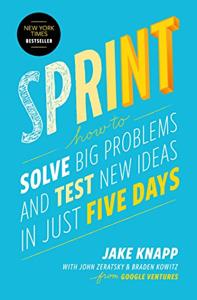
Want to learn the ideas in Sprint better than ever? Read the world’s #1 book summary of Sprint by Jake Knapp here.
Read a brief 1-Page Summary or watch video summaries curated by our expert team. Note: this book guide is not affiliated with or endorsed by the publisher or author, and we always encourage you to purchase and read the full book.
Video Summaries of Sprint
We’ve scoured the Internet for the very best videos on Sprint, from high-quality videos summaries to interviews or commentary by Jake Knapp.
1-Page Summary of Sprint
Initier le sprint
The Sprint is a unique methodology that allows you to answer critical questions and test ideas with customers. To start a sprint, first make sure the project’s relevant by addressing surface-level questions. Then form an “A-team” of seven samurai profiles:
‘A Decision Maker’: This person can be the CEO of a startup or any other decision maker with in-depth knowledge about the problem. The Decision Maker makes final decisions regarding the project and must make time to participate in it for one week. * ‘An expert financier’: This person could be a financial director or other manager responsible for financial transactions of an organization. * ‘An expert marketing’: this professional is responsible for communication or public relations at an organization.
An expert client should be a salesperson, because they are in contact with your clients on a regular basis. * An expert technician or logistics person is also critical to the success of your company; this person could be an engineer or someone who has excellent knowledge about production and logistics.
‘An expert product designer’ : a product manager who is responsible for designing your products has the required skills to do so.
An opponent: invite someone to your project who has a different point of view, because this person is likely to come up with innovative solutions.
After you choose your team, you need to select a facilitator who will manage the process of the sprint and act as conductor. Now define when and where the sprint will take place. For this, you must block five consecutive days (for example from Monday to Friday, from 10:00 to 17:00) and meet every day in the same room. Plan two coffee breaks during the day and one longer lunch break. Ban computers, phones, tablets in that room where the sprint will be held. Arrange for two large whiteboards with post-it notes and markers.
Here’s the breakdown of your 5-day sprint:
Lundi : orienter le sprint
Begin by defining an end goal. It should embody the values and ambitions of the entire team. Once you’ve identified it, write it at the top of your first whiteboard so that it remains visible throughout the sprint. Imagine this goal is unsuccessful, and try to figure out why that’s so. Now make a list of questions that must be answered during this sprint, and write them on your second whiteboard. This approach helps you “translate” previously identified problems into questions. Next comes creating a roadmap or story diagram, which will help you throughout the week as you come up with solutions and track progress. Start by writing an outline for your story diagram on your first whiteboard using these steps :
- Create a list of actors (left side): these are the characters that play an important role in your story. This usually refers to different customer categories or sometimes your sales team. 2. Write down the ending of the story (right side): identifying the end is much simpler than finding its middle part. 3. Put words or arrows between both: you should simplify as much as possible so that it remains functional for you and others to use later on 4/ Make it simple: your road map should have no more than 5-15 steps so that it’s easier for people to identify solutions
Ask for help: make sure that your diagram is accessible and understood by all.
Once you’ve identified the problem, spend a whole day questioning your team to get more information. Use the HMW method (How Might We…) for taking notes. Write ‘HMW’ at the top left of each note card and write questions on them when you hear something interesting. Post-its with these questions should be placed on a wall and categorized by themes using voting stickers. Choose promising ideas that are voted most popular among participants by placing sticky tags on them and stick those post-its onto your diagram where they fit best after voting is over. Finish this first Monday session by choosing one element from your diagram as your sprint goal—your target for five days’ work in fixing it up





